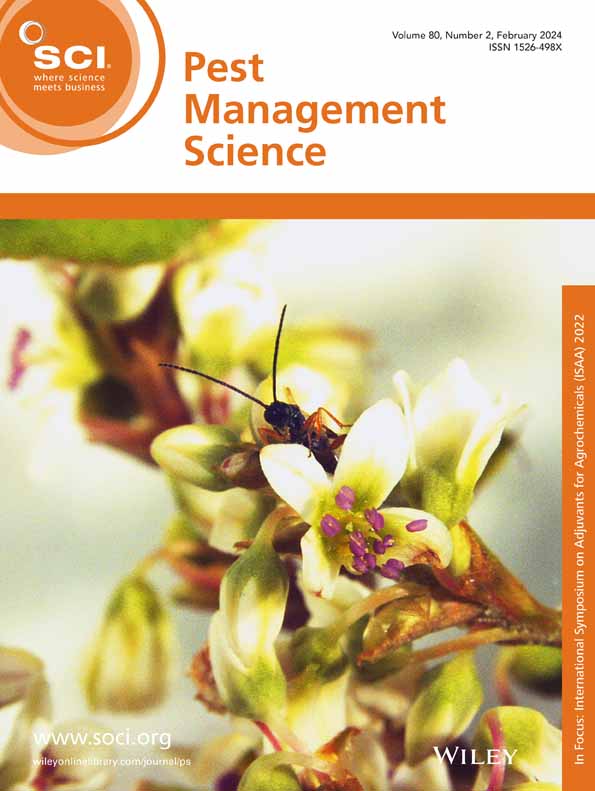以柠檬醛为基础的酰胺衍生物提高了甲基克雷索辛对茄枯丝核菌的抗真菌活性。
IF 3.8
1区 农林科学
Q1 AGRONOMY
引用次数: 0
摘要
水稻纹枯病真菌病原菌——茄枯菌威胁着全球粮食安全。长期使用一种常见的杀菌剂甲基克雷索辛(KM)已导致耐药性和有效性降低。本研究探讨了柠檬醛酰胺衍生物与KM的协同作用,并解释了其潜在的机制。结果化合物d25的增效效果最显著,在混合物中摩尔比为25%时,增效比达到峰值(SR = 2.66±0.67)。当摩尔比为10%时,混合物(Mix)在体外和体内均表现出显著的抗真菌活性,有效降低菌丝干重,增强水稻叶片保护作用。机制研究表明Mix破坏了三羧酸(TCA)循环,从而抑制了能量代谢。此外,d25干扰花生四烯酸代谢,破坏细胞膜修复机制,增强KM的杀真菌效果。毒性评价表明,d25对人类细胞系的细胞毒性最小,对蜜蜂和斑马鱼的急性毒性较低。结论研究结果阐明了d25和Mix的增效作用机制,表明它们具有杀菌剂增效作用的潜力。本研究为提高化学防治措施的有效性奠定了坚实的理论和实践基础,为开发安全高效的杀菌剂配方提供了新的思路。©2025化学工业协会。本文章由计算机程序翻译,如有差异,请以英文原文为准。
Citral-based amide derivatives improve the antifungal activity of Kresoxim-methyl against Rhizoctonia solani.
BACKGROUND
Rhizoctonia solani, the fungal pathogen causing rice sheath blight, threatens global food security. Prolonged use of Kresoxim-methyl (KM), a common fungicide, has led to resistance and reduced effectiveness. This study investigates the synergistic effects of citral-based amide derivatives with KM and explains the underlying mechanisms.
RESULT
Among the tested derivatives, compound d25 exhibited the most pronounced synergistic effect, achieving a peak synergistic ratio (SR = 2.66 ± 0.67) at a molar ratio of 25% in the mixture. At a molar ratio of 10%, the mixture (Mix) demonstrated significant antifungal activity both in vitro and in vivo, effectively reducing mycelial dry weight and enhancing rice leaf protection. Mechanistic studies revealed that Mix disrupted the tricarboxylic acid (TCA) cycle, thereby inhibiting energy metabolism. Additionally, d25 interfered with arachidonic acid metabolism, impairing cell membrane repair mechanisms and enhancing the fungicidal efficacy of KM. Toxicity assessments revealed that d25 exhibited minimal cytotoxicity against human cell lines and low acute toxicity toward Apis mellifera L. and zebrafish.
CONCLUSION
The findings elucidate the synergistic mechanisms of d25 and Mix, underscoring their potential as effective fungicide synergists. This study establishes a robust theoretical and practical foundation for enhancing the efficacy of chemical control strategies against R. solani, providing new insights into the development of safe and efficient fungicide formulations. © 2025 Society of Chemical Industry.
求助全文
通过发布文献求助,成功后即可免费获取论文全文。
去求助
来源期刊

Pest Management Science
农林科学-昆虫学
CiteScore
7.90
自引率
9.80%
发文量
553
审稿时长
4.8 months
期刊介绍:
Pest Management Science is the international journal of research and development in crop protection and pest control. Since its launch in 1970, the journal has become the premier forum for papers on the discovery, application, and impact on the environment of products and strategies designed for pest management.
Published for SCI by John Wiley & Sons Ltd.
 求助内容:
求助内容: 应助结果提醒方式:
应助结果提醒方式:


